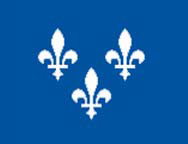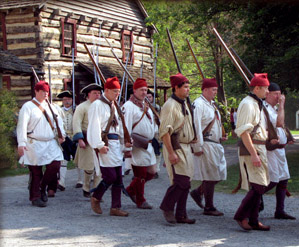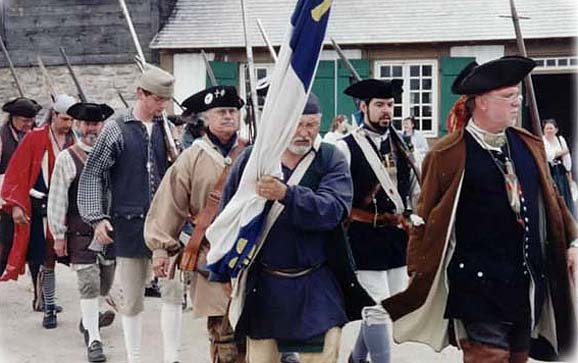OBJECTIVE:
In accordance with the New York Company policy of being able to contribute positively and correctly at
events, this document was created to establish the proper clothing for portraying the French Canadian
Milice during the French and Indian War.
This impression could be quite interesting in that we will be learning to drill with commands given in
French as well as a different culture.
The tactics used by la Milice Canadienne was nearly the same as used by the Native Americans. These same
tactics were also used by Robert Rogers and his Rangers whom we represent.This page (above) contains several
photos of Milice that will give the reader an idea of the clothing worn.
BACKGROUND:
At the beginning of French colonization in America, the colonists of New France had to face the threat posed
by the Iroquois tribes, especially near Montreal and Trois-Rivières. Since the colonists could not be
adequately protected by the French military, it became necessary to train a group of armed men to provide
defense. This group would be formed locally with people the colony.
Thus in 1669, King Louis of France, the militia was officially established in New France. Each resident
(male usually) aged between 16 and 60 years had an obligation to do military service. There was a company of
militia in each parish, each with 50 to 80 men. Each company was led by a captain of militia, elected by the
militia of his company. In addition to his military duties, the captain of the militia was also responsible
for maintaining justice and maintenance of roads. He also held the governor of New France the power to enforce
the directives of the central authorities.
In peacetime, members of militia companies were training once a month, Sunday and holidays. Once or twice a year,
all companies met in a region to practice major exercises. They then had to get a weapon for themselves. In
wartime, however, weapons were loaned for the duration of the conflict to those who did not. The militia
companies borrowed many of their habits from the Native Americans. Excelling in the war of skirmish in the woods,
unlike the French soldiers used in battle order, The effectiveness of the milice quickly became legendary among
his enemies. They would usually serve alongside the Native Americans that were loyal to French and the Compagnies
Franches de la Marine.
EQUIPMENT ISSUED TO MILICIENS:
NOTE: This list is from the Bourlamaque Papers, National Archives of Canada (1757).
During Summer:
1 blanket; 1 capot or bougrine (capot or a loose blouse or cape?); 2 cotton shirts;
1 breech cloth; 1 pair of leggings (mitasses); 2 skeins of thread; 6 needles; 1 awl; 1 firesteel;
6 gunflints; 1 butcher knife; 1 comb; 1 gunworm; 1 tomahawk; 1 pair moccasins every month.
For Winter (in addition to Summer):
2 pairs of short stockings (socks); 1 pair of mittens; 1 vest; 2 folding knives; 1/2 aune of blanket to make
leggings (mitasses); 2 pair of deerskin shoes; 1 greased deerskin; 2 portage collars; 1 toboggan;
1 pair of snowshoes; 1 bearskin.
Augmentation for every MILITIAMAN:
1/2 pound (livre) of gunpowder; 1 pound (livre) of balls; 1 pound (livre) of tobacco;
1 axe for 2 men; 1 tarpaulin and 1 cooking boiler for every 4 men.
This list of clothing and equipment issued to the Miliciens is from Bouganville
- aide de camp to General Louis-Joseph de Montcalm-Gozon, Marquis de Saint-Veran (Montcalm):
During Summer:
1 capot; 1 wool stocking cap; 2 cotton Shirts; 1 breech cloth; 1 pair leggings; 2 pairs shoes; 1 blanket;
2 skeins of thread; 6 needles; 1 awl; 1 firesteel; 1 comb; 1 worm; 6 gunflints; 2 siamois knife, 1 boucheron knife;
1 tomahawk; 1 oilcloth for every 4 soldiers
For Winter (in addition to Summer):
2 tumplines; 1 toboggan; 1 pair snowshoes; 1 bearskin; 1 pair of mittens; 1 gilet; 2 pairs deerskin moccasins;
1 dressed deerskin
Both of the lists are found in Steve Delisle’ book “The Equipment of the New France militia,
1740-1760”
ARMS AND ACCOUTREMENTS:
The most common firearm of the Miliciens was the Tulle Fusil which was a hunting smoothbore
firearm of the period. There has been no documentation of French Milice carrying rifles of any kind.
Musket (le Fusil): From the 1690s to the 1740s the musket carried was predominantly the Marine
model made in Tulle. During the 1740s the Ministry of Marine bought the 1728 style muskets from St. Etienne.
There is conflicting information on the type of finish that was used on the weapons. Acceptable muskets include:
- Charleville Model 1763 altered to Model 1728 (bright)
- Tulle Marine (bright)
- Fusil de Chasse (browned or blued)
- Fusil Grenadier (bright)
- Fusil Fin (browned or blued)
- Type C or D French trade fusil (bright)
- British Trade gun
- Any firelock that may have been found on the battlefield or aquired through trade
Knives (Couteaux) were commonly carried, one hanging around the neck,
one at the waist in the sash, and one attached on the outside of the leg in the leg tie. These should
all have a sturdy leather sheath, and for extra precaution we suggest having a leather thong attached
to your belt and sheath.
A tomahawk (Casse-tête) was also a common tool carried by the Milice.
This too should be in a sturdy leather sheath for safety.
Milice wore a powder horn and shooting pouch, not a cartridge
box. The horn was commonly 12 to 14 inches long in this period and the pouch was made of a sturdy hide
such as cow or pig. These were hand sewn, and not laced and had a good flap for protection.
A canteen was commonly carried. These were often made from a dried gourd
and hung around the neck and shoulder with a leather thong. A leather covered bottle with a cork stopper
is also fine, as is the period tin canteens. The canteens are best covered with leather or wool.
Blanket rolls, powder horns, ball bags, haversacks/knapsacks, may be carried, as
part of field/campaign impression
To get a better description of the clothing and equipment used by the Miliciens, follow the instructions below.
Click here to get a PDF copy of the la Milice Canadienne information.
REFERENCE BOOKS:
Delisle, Steve. The Equipment of New France Militia,1740-1760
Bel Air, MD : Kebeca Liber Ata Co., 1999
ISBN 0967108500
NOTE: - May be hard to find, out of print.
Book Title: Memoir upon the late war in North America, between the French and English, 1755-60
Author: Pouchot, Pierre, Brian Dunnigan (Editor), Michael Cardy (Translator)
Publisher: Old Fort Niagara Association, Incorporated
Publication Date: 1994
ISBN-10: 111316204X
ISBN-13: 9780941967143
Book Title: The Fusil de Tulle in New France 1691-1741
Author: Russel Bouchard
Publisher: Museum Restoration Service
Publication Date: 1998
ISBN-10: 2910761630
ISBN-13: 978-2910761639
Book Title: The French Trade Gun in North America 1662-1759
Author: Kevin Gladysz
Publisher: Andrew Mowbray Publishers, Inc.
Publication Date: February 23, 2011
ISBN-10: 1931464472
ISBN-13: 978-1931464475
Books Written by Bob Bearor
Published by Heritage Books, Bowie Maryland
Book Title: Battle on Snowshoes
Publication Date: 1997
ISBN 0-7884-0619-1
- Clothing description of the Milice, pgs 21-23
Book Title: Leading by Example: Partisan Fighters & Leaders of New France, 1660-1760, Volume One
Publication Date: May 1, 2002
ISBN-10: 0788420682
ISBN-13: 978-0788420689
Description: Volume one tells the stories of two great partisans, Jaques LeMoyne de Ste. Helene and
Charles –Michel de Langlade. Ste. Helen led the grueling winter attack on Schenectady and battled
brilliantly in the siege and battle of Quebec in 1690. The 9 other LeMoyne brothers, who some
of the gretest leaders in New France’s history, are also discussed in the St. Helene chapter.
Book Title: Leading by Example: Partisan Fighters & Leaders of New France, 1660-1760, Volume Two
Publication Date: March 1, 2003
ISBN-10: 0788423487
ISBN-13: 978-0788423482
Description: Volume Two covers Daniel Greysolon DuLuth, Madeleine Vercheres, St. Luc de la Corne, Daniel Beaujeu and Jean-Daniel Dumas,
with a brief chapter on native foods for wilderness survival.
Book Title: Leading by Example: Partisan Fighters & Leaders of New France, 1660-1760, Volume Three
Publication Date: 2004
ISBN-10: 0788425145
ISBN-13: 978-0788425141
Description: In this Bob Bearor's third and final book in the 'Leading by Example' trilogy we learn of the exploits of
Nicolas D'Allieboust de Manthet, Joseph-Francios Hertel de La Fresniere, the partisan named Wolff (not to be confused with General
Wolff, British),Gaspard-Joseph Chaussegros de Lery, Jospeh Marin de La Malgue and last but not least Jean-Baptisie Levreault de Langis
de Montegron (Langy). This volume has several Native Americans that were outstanding.
This series of books is a good starting point for one to learn about the New France.





